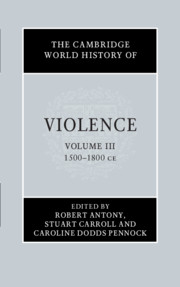Book contents
- The Cambridge World History of Violence
- The Cambridge World History of Violence
- The Cambridge World History of Violence
- Copyright page
- Contents
- Figures
- Maps
- Contributors to Volume iii
- Introduction to Volume iii
- Part I Empire, Race and Ethnicity
- Part II Cultures of War and Violence
- Part III Intimate and Gendered Violence
- Part IV The State, Punishment and Justice
- Part V Popular Protest and Resistance
- Part VI Religious and Sacred Violence
- Part VII Representations and Constructions of Violence
- 29 African Ritual Violence: Close Combat in Western Africa and the Diaspora
- 30 Intercultural Emblems of Violence in the Spanish Colonisation of the Americas
- 31 Spectacles of Violence in China
- 32 Visualising Violence in Reformation Europe
- 33 Violence, Civil Society and European Civilisation
- Index
- References
29 - African Ritual Violence: Close Combat in Western Africa and the Diaspora
from Part VII - Representations and Constructions of Violence
Published online by Cambridge University Press: 13 March 2020
- The Cambridge World History of Violence
- The Cambridge World History of Violence
- The Cambridge World History of Violence
- Copyright page
- Contents
- Figures
- Maps
- Contributors to Volume iii
- Introduction to Volume iii
- Part I Empire, Race and Ethnicity
- Part II Cultures of War and Violence
- Part III Intimate and Gendered Violence
- Part IV The State, Punishment and Justice
- Part V Popular Protest and Resistance
- Part VI Religious and Sacred Violence
- Part VII Representations and Constructions of Violence
- 29 African Ritual Violence: Close Combat in Western Africa and the Diaspora
- 30 Intercultural Emblems of Violence in the Spanish Colonisation of the Americas
- 31 Spectacles of Violence in China
- 32 Visualising Violence in Reformation Europe
- 33 Violence, Civil Society and European Civilisation
- Index
- References
Summary
Ritual violence in the form of regulated types of close combat had been widespread in western Africa, even on the battlefield. The arrival of Europeans along the coast and an invading Moroccan army equipped with firearms in the sixteenth century challenged more ritualised approaches to combat in many areas of western Africa. In the savannah regions however, ritualised close combat in the form of martial contests remained important as military training that continued to be effective on the battlefield. In western Sudan, competitions of wrestling, equestrian acrobatics and fencing prepared elite males for battlefield combat, which was dominated by cavalry heroics. In the savannah regions of Angola, fighters performed danced combats to pay tribute to rulers, to develop combat skills crucial for the battlefield and to exercise their king’s leopard-like power over life and death on the battlefield. Elements of these ritual violence traditions were carried to the Americas where enslaved Africans and their descendants armed themselves with these practices even under slavery.
- Type
- Chapter
- Information
- The Cambridge World History of Violence , pp. 573 - 590Publisher: Cambridge University PressPrint publication year: 2020

